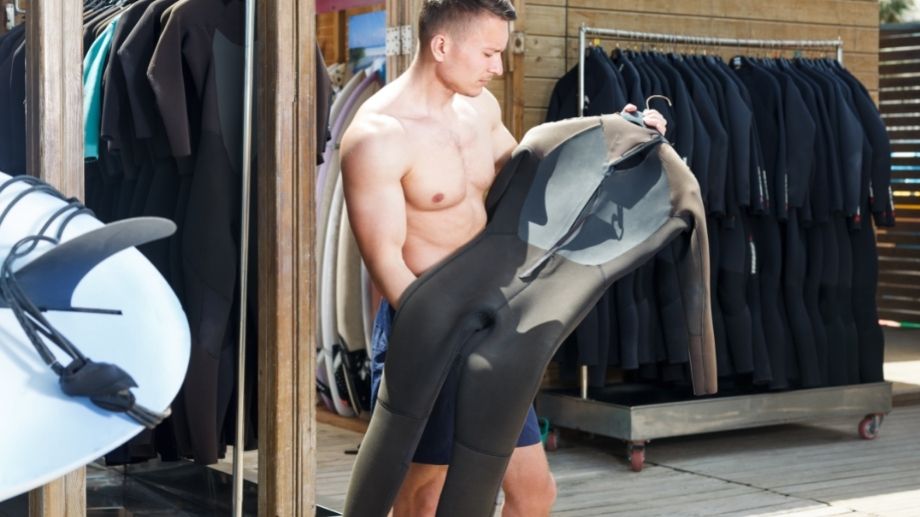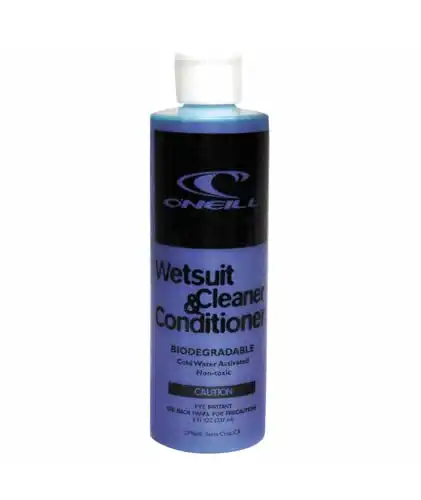When you buy a new wetsuit, it can be tough to tell if you got the fit right.
Is it too tight on my chest? Are my arms able to move freely? Will it loosen up over time?
A big part of sizing a wetsuit is considering how it will fit after it’s broken in. But how exactly do you break in a new wetsuit properly?
Modern wetsuits don’t need much breaking in, simply wearing the wetsuit will help it conform to your body. To speed up the process, however, a light stretching routine while wearing the wetsuit may help. A few squats, lunges, and jumping jacks should do the trick.
In the past wetsuits were made out of tougher and stiffer rubber materials. Wetsuits needed to be bought slightly small as they would stretch over time. Breaking them in would speed up this stretching process. However, now wetsuits are made from much more sophisticated and stretchy materials that no breaking in is required and the wetsuit is unlikely to stretch with age.
I’ve owned many wetsuits over the years and have learned a thing or two about breaking them in. Keep reading to learn the best ways to break in a new wetsuit.
Does A New Wetsuit Need To Be Broken In?
Believe it or not but a new wetsuit doesn't actually need to be broken in.
Advances in wetsuit technology and a wider range of available fits have more or less eliminated the traditional ‘breaking in’ process needed by the wetsuits of the past.
Better paneling, seams and stretchier neoprene make modern wetsuits more comfortable and more immediately usable. But that doesn’t mean your wetsuit will fit the same way the day you buy it and after its tenth or one hundredth wear, but the better wetsuits get the less they tend to change in size over time.
With use, you’ll notice that the wetsuit might feel like it has shrunk a little bit. In reality the wetsuit probably hasn't shrunk but the rubber becomes stiffer and less stretchy. This leads it to feel more restrictive and probably a bit tighter than usual.
Going out of your way to break in a wetsuit isn’t really needed. The best thing you can do is to make sure it fits you well and to just use it normally.
Normal usage will help the wetsuit to conform to your body a bit more and if it is tight in some areas then regular use can potentially cause your wetsuit to stretch in these areas over time making it a better fit.
Do New Wetsuits Stretch Out? Do They Get Looser Over Time?

While neoprene doesn’t stretch out or loosen much, you’ll still be able to feel the difference between a brand new wetsuit and an older wetsuit that has seen many seasons and a lot of sun. Likewise, a dry wetsuit will feel a little tighter than a wet one.
If the wetsuit is just too small for you, however, it’s likely to remain that way. Counting on an undersized wetsuit to stretch to fit you isn’t likely to work out. There are some ways to stretch a wetsuit that is too small but these are unreliable and can sometimes do damage to your wetsuit.
When trying on your wetsuit make sure to get the right size for you. Here are some ways to tell if a wetsuit is too small so you don't buy the wrong one.
That being said, wetsuits will eventually begin to loosen in some areas — which is actually a sign that the neoprene is wearing out and you'll likely need to replace your wetsuit soon.
When this started happening to me recently the next season the zipper completely broken on my wetsuit and the whole suit needed to be replaced. It was a sad, cold (and expensive) moment for me.
The arms and legs of your wetsuit may stretch out a bit from repeating pulling while putting the wetsuit on and taking it off. To avoid damaging the wetsuit, avoid pulling too hard and be careful not to use your fingernails — neoprene is a fairly delicate fabric.
When neoprene ages or isn’t cared for properly, it loses elasticity. This is most common near the shoulders because of improper hanging and the frequent movement of the arms during swimming, surfing, and diving. Make sure to use a good wetsuit hanger when drying your wetsuit to protect the shoulders from stretching.
How Tight Should A New Wetsuit Be?

The purpose of a wetsuit is to insulate your body heat and keep you warm. To do its job, it needs to fit snugly — tight but not uncomfortably so.
A loose wetsuit allows cold water to circulate, moving heat away from the body. An overly tight wetsuit restricts movement and may constrict breathing.
Anyone who's had a wetsuit that is too small can attest to the neck line rash you get or the way it pulls up super tight on your crotch making for an incredibly uncomfortable surf or dive.
If your wetsuit has creases, folds, or pockets of air, it’s either too big for you or just isn’t a good cut for your body shape.
My daughter recently tried on her mum's wetsuit to see if it would fit. While the length was fine the amount of empty space in the bust area made the wetsuit a laughable fit for my daughter. Needless to say she did NOT wear it surfing and if she did it would have filled up with a lot of water and made her incredibly cold.
If blood flow is restricted at your wrists or ankles, it’s nearly impossible to get on, or your breathing feels more difficult, it’s too small for you.
Keep in mind, it’s normal to feel like movement is slightly restricted in a brand new wetsuit. Even a perfectly fit wetsuit will feel a bit stiff at first and the thicker the wetsuit (for colder water) the more restricted your movement will feel.
Thicker wetsuits may feel especially awkward to move in and will take a while longer to break in. A thinner wetsuit will have a more natural feeling the first time you try it on.
This is because a lot of material on your body naturally restricts movement. But you need to make sure you tell the difference between this natural restriction and your wetsuit being too small.
Wetsuits often feel particularly stiff when dry. They will loosen up pretty noticeably when wet.
The bottom line is that a wetsuit needs to fit properly when you buy it.
Breaking in a wetsuit will make it more comfortable as it conforms to your body, but it won’t stretch the suit out if it's too small.
What Should You Do With A New Wetsuit?

When you get a new wetsuit, you can speed up the breaking in process by doing a basic stretching routine when trying it on and before each use.
Some squats, lunges, and jumping jacks are a good starting point. It’s a good habit to get into before surfing or diving regardless and will help stretch out the wetsuit faster.
Ease of movement is especially helpful for surfing and swimming, where increased flexibility is needed.
If you’re diving, the buoyancy of your new wetsuit is another important consideration.
Modern materials make modern wetsuits more buoyant, which is great for swimming and surfing but not so great for scuba diving. Thicker suits and brand new suits are also particularly buoyant.
Before going for a dive, you may want to test your buoyancy in the new suit to properly tune your weight belt. You may need to add some weight to reach a neutral buoyancy.
Do You Need To Wash A Wetsuit Before You Wear It?

A wetsuit doesn’t necessarily need to be washed when you first get it, but it’s not a bad idea. It’s a good habit to wash any new piece of clothing before wearing it.
Wetsuits bought from a store may have been tried on multiple times by multiple people. And we all know that hygiene isn’t everyone’s strong suit.
If you ordered online, your wetsuit may have collected dust and dirt while in warehouse storage. There’s no harm in rinsing it off.
Just turn your wetsuit inside out, submerge it in cool water, and massage a wetsuit cleaner into it. Rinse thoroughly with cool water and hang to dry. Click here for the full guide on exactly how to wash a wetsuit.
You may also want to use a wetsuit shampoo or a natural wetsuit shampoo alternative to give it a really thorough cleaning. This will also make it smell really nice and fresh too.
The O'Neill Wetsuit Cleaner is my favorite option. It has a nice citrus smell and has an included conditioning agent to extend the lifespan of your wetsuit.
With a nice citrus smell this wetsuit cleaner is great at removing stubborn odors. Includes a conditioning agent to help extend the suit's lifespan while killing odor inducing bacteria.
Non-toxic and biodegradable it's a great way to give your wetsuit the cleaning it deserves.
Use a wetsuit hanger or a wetsuit dryer to help your wetsuit dry faster and to protect the shoulders from stretching out.
And remember, never use strong detergents when cleaning a wetsuit. They’re too harsh and may damage the neoprene.





